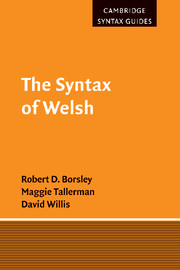10 - Welsh as a VSO language
Published online by Cambridge University Press: 01 October 2009
Summary
Subject-initial constituent order predominates in the languages of the world. Perhaps 10–12% of the world's languages have verb-initial finite clauses (Ruhlen 1987), so from a typological perspective, Welsh – with VSO surface word order – is in a relatively rare class. In this chapter we examine, both from a traditional typological and from a generative perspective, the question of whether or not there exists a distinct VSO – or more generally, verb-initial – syntactic ‘type’.
Proposed universals from work in traditional syntactic typology are discussed in section 10.1. Welsh has a strongly head-initial phrase structure, but how exactly should this be characterized, and what specific word order correlations are predicted to occur? What kinds of explanation have been proposed for the observed patterns?
Proposals from the generative literature are discussed in section 10.2. Various properties have been claimed to characterize verb-initial languages, including verb agreement only with the first conjunct in coordinate structures; inflecting prepositions; lack of a lexical verb ‘have’; agreement inflections closer to the verb stem than tense inflections; existence of pre-verbal particles marking tense/mood/aspect, interrogatives and polarity. We evaluate these, and other, claims in light of data from Welsh and other verb-initial languages, and conclude that no syntactic features uniquely characterize verb-initial languages.
Section 10.3 briefly considers various analyses of verb-initial languages within generative frameworks, and concludes that there are a number of distinct analytical pathways to VSO (and VOS) word order. It therefore seems clear that neither in terms of superficial distinguishing features, nor in terms of appropriate analysis, is there a single verb-initial language type.
- Type
- Chapter
- Information
- The Syntax of Welsh , pp. 338 - 366Publisher: Cambridge University PressPrint publication year: 2007
- 1
- Cited by



